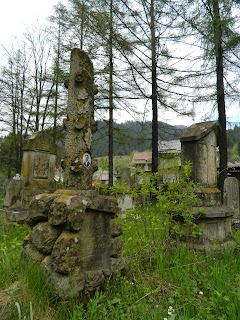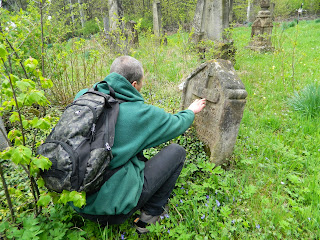Contact
Unique, handmade wearable art.
Made with joy, for free spirits!
anca_gabby_3@yahoo.com
https://www.facebook.com/anca.gabi.5
Made with joy, for free spirits!
anca_gabby_3@yahoo.com
https://www.facebook.com/anca.gabi.5
luni, 25 mai 2015
Stonemasons' Cemetery
Din capitolul "cand vrei in excursie", dar e mijlocul saptamanii sau ai doar cateva ore la dispozitie, ne-am gandit pe unde sa ne mai plimbam, local. Si privind pe fereastra, ne-am amintit ca peste drum e Raul Moldova si o plimbare pe garla n-are cum sa nu ne incarce cu energie. Iar in drumul spre apa, am trecut prin cimitir, care desi poate parea un loc sinistru pentru o plimbare, s-a dovedit un veritabil parc istoric.
Aceasta deoarce cimitirul acesta adaposteste pietre de mormant foarte vechi, care sunt parte din istoria localitatii si din istoria tarii.
EN: Part of the "when you want a trip" chapter, but it's the middle of the week or you only have a couple of hours to spare, we thought where to go, local. And, looking on the window, we remembered we live across the street of the River Moldova and a walk along the shore is always energizing. And on the way to the water, we crossed the cemetery, which, although it seems a bit creepy for a walk, it proved to be a history park. This is because the cemetery is home of really old tombstones, which are part of the history of the village and of the country as well.
In jurul anului 1880, in zona dintre comuna Vama si Paraul Hurghis 9aproape de Campulung Moldovenesc, Suceava), dupa terminarea caii ferate, au inceput sa soseasca pietrari italieni, care s-au alaturat comunitatii Eisenau (asezare populata de mineri germani, intre 1808-1809).
EN: Around 1880, in the area between the Vama settlement and Hurghis (close to Campulung Moldovenesc, Suceava) after the railway was made functional, started to arrive italian stonemasons who joined the Eisenau community (a village populated with german miners, between 1808-1809).
Ei au devenit in curand cunoscuti si foarte apreciati pentru mestesugul lor: cioplitul si sculptatul pietrei. Pietrarii au creat toate ornamentele si pietrele funerare din Bucovina, dar si din Iasi sau Botosani. Statuia lui Stefan cel Mare din Suceava a fost de asemenea munca unui sculptor italian din Eisenau.
EN:They soon became well known and apreciated for their craft: stone carving. The stonemasons created all the ornaments and thumbstones from around Bucovina, but also Iasi or Botosani. The statue of Stefan cel Mare in Suceava was also the work of the Eisenau italian carvers.
In Primul Razboi Mondial, atat trupeleaustriece cat si cele rusesti au foat pe rand cantonate in zona, iar in urma lor au ramas transee care brazdaza Dealul Hurgis.
Satul se numeste acum Prisaca Dornei, iar in jurul anului 1930 a primit porecla de "Rosendorf" sau "Satul trandafirilor", datorita curtilor frumoase ornate cu trandafiri de soi.
EN: In the first World War, both the austrian and russian troops settled here and left tranchees deep in the Hurghis hill.
The village is now called Prisaca Dornei and around 1930s got the nickname "Rosendorf" or "Roses village", because all the beautiful front yards planted with roses.
In 1940, Baronul von der Goltz a ordonat intoarcerea populatiei de origine germana din eisenau si mai mult de jumatate dintre ei s-au relocat in Germania.
EN:In 1940, the Baron von der Goltz orders the returning of the german people of Eisenau and more than half of them go back to Germany.
Singurele semne ramase in urma pietrarilor sunt pietrele de mormant sculptate in roca din cimitirul local al Prisacii Dornei, unde mai pot fi citite nume italiene sau germane.
EN: The only signs left now by these craftsman are the thumbstones carved in rock from the local cemetery of Prisaca Dornei, where there can still be read italian or german forgotten names.
Abonați-vă la:
Postare comentarii (Atom)























Niciun comentariu:
Trimiteți un comentariu